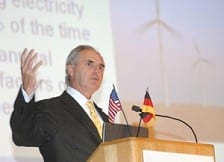Conference connects German, Iowa wind energy companies

.bodytext {float: left; } .floatimg-left-hort { float:left; margin-top:10px; margin-right: 10px; width:300px; clear:left;} .floatimg-left-caption-hort { float:left; margin-bottom:10px; width:300px; margin-right:10px; clear:left;} .floatimg-left-vert { float:left; margin-top:10px; margin-right:15px; width:200px;} .floatimg-left-caption-vert { float:left; margin-right:10px; margin-bottom:10px; font-size: 10px; width:200px;} .floatimg-right-hort { float:right; margin-top:10px; margin-left:10px; margin-bottom:10px; width: 300px;} .floatimg-right-caption-hort { float:left; margin-right:10px; margin-bottom:10px; width: 300px; font-size: 10px; } .floatimg-right-vert { float:right; margin-top:10px; margin-left:10px; margin-bottom:10px; width: 200px;} .floatimg-right-caption-vert { float:left; margin-right:10px; margin-bottom:10px; width: 200px; font-size: 10px; } .floatimgright-sidebar { float:right; margin-top:10px; margin-left:10px; margin-bottom:10px; width: 200px; border-top-style: double; border-top-color: black; border-bottom-style: double; border-bottom-color: black;} .floatimgright-sidebar p { line-height: 115%; text-indent: 10px; } .floatimgright-sidebar h4 { font-variant:small-caps; } .pullquote { float:right; margin-top:10px; margin-left:10px; margin-bottom:10px; width: 150px; background: url(http://www.dmbusinessdaily.com/DAILY/editorial/extras/closequote.gif) no-repeat bottom right !important ; line-height: 150%; font-size: 125%; border-top: 1px solid; border-bottom: 1px solid;} .floatvidleft { float:left; margin-bottom:10px; width:325px; margin-right:10px; clear:left;} .floatvidright { float:right; margin-bottom:10px; width:325px; margin-right:10px; clear:left;} When it comes to wind energy, German manufacturers view the United States as a nearly limitless market. That says a lot, considering that Germany currently produces more energy from wind than any other nation.
Last week, representatives from eight major German wind energy companies got a firsthand look at Iowa’s emerging wind energy industry. They were among about 150 participants at a wind energy conference in Des Moines. Hosted by the German American Chamber of Commerce of the Midwest, the conference’s primary goal was to open the door to potential partnerships between German and American wind energy companies.
Gov. Chet Culver, who in September led a delegation from Iowa to an international wind energy conference in Germany, welcomed the delegates “to what we hope becomes the renewable energy capital of the world.”
He also issued a challenge for each of the presidential candidates to commit to supporting a renewable portfolio standard as part of the energy bill now in Congress. That proposed energy policy would set a goal for the United States to generate at least 15 percent of its energy from renewable sources by 2020.
Now third in the nation in wind energy production behind California and Texas, Iowa has more than 1,000 operational wind turbines. The state’s goal is to double that number by 2015. The United States is currently the third-largest wind energy producing country, behind Germany and Spain.
Within the past two years, Culver noted, three major wind energy equipment manufacturers, Acciona Energy, Siemens Corp. and Clipper Windpower Corp., have chosen Iowa to establish their North American production facilities. Wisconsin-based Hendricks Industries announced its plans last month to begin construction of a plant in Keokuk. Combined, those plants will employ nearly 900 people. A recent report by the Sierra Club and the United Steelworkers of America indicates that Iowa has the potential to create more than 5,100 manufacturing jobs related to wind energy.
“We also hope that as a result of this (conference) you decide to invest in Iowa: either start a company, expand a company or relocate a company here,” Culver told attendees. “If you decide to invest in Iowa, we will be with you every step of the way. You can ask Clipper; you can ask Acciona. We continue to work with them on an ongoing basis.”
The German Energy Agency, one of the sponsors of the event, conducts about 50 such events for its energy companies each year, said Christine Woerlen, the agency’s head of renewable energy.
“I was impressed by the environment our companies can find here; it’s unbelievable,” Woerlen said at the end of the daylong conference. “Iowa is really positioning itself in an extremely smart way to do a lot of business in a sector that’s going to explode within the next five years.”
During a roundtable discussion held the previous day, the German delegates met with state legislators, utilities board members and representatives from utility companies. “We were able to gain good insight in how the market works, who the players are, and the usual barriers you’ll encounter,” Woerlen said. “So this was very enlightening.”
Last year, Germany produced 12 percent of its energy from renewable energy sources, with about one-quarter of that renewable power generated from wind turbines. By comparison, the United States in 2006 generated 0.6 percent of its energy from wind power.
Last week, the American Wind Energy Association revised its projections for completed U.S. projects. AWEA reports that the U.S. wind energy industry is currently on track to complete new installations totaling 4,000 megawatts in capacity in 2007, a 63 percent increase over the 2,454 MW of new capacity added in 2006. The added capacity is enough to provide electricity to more than 1 million homes.
“The U.S. is a gigantic market for the wind energy industry,” said Bob Gates, a vice president for Clipper and AWEA’s president. The association’s goal, Gates told participants, is to increase wind’s share to 20 percent of total U.S. energy production.
The only government support the industry receives is a two-year tax credit initially enacted in 1992 that has been renewed sporadically, Gates said. That has resulted in a boom-bust cycle that has hurt the industry, he said. Because of that, Congress should enact a renewable portfolio standard, which would create more stability for the industry, he said.
The worldwide demand for parts for the growing wind energy industry has also become one of its biggest challenges, Gates said.
“So the constraint on wind turbines today is not putting them together; it’s the upstream component providers,” he said. “There aren’t enough gears, not enough gear-cutting shops.”
The wind energy equipment industry also competes with other industries, such as construction machinery manufacturers, for the same parts, such as the bearings that are used in both turbines and cranes. “So wind turbines are bumping up against the industrial capacity of the world,” Gates said.
In recognition of that gap, the participating German companies represented site development consultants and parts and services companies rather than tower manufacturers.
Matthias Brandt, sales director of Deutsche Rotor and Turbine Service in Bremen, said it was his company’s first visit to the United States. DRTS specializes in a wide range of repairs, service and maintenance for wind turbines.
“We are screening the market for joint ventures with all of the actors in the market,” he said during a cocktail reception at the end of the event. “We concentrated on Europe first, but we said, ‘Now we want to travel to this very interesting and very friendly country, and maybe start some activity.'”







